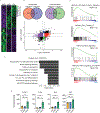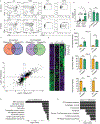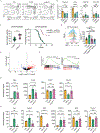Loss of thymocyte competition underlies the tumor suppressive functions of the E2a transcription factor in T-ALL
- PMID: 38155245
- PMCID: PMC12523820
- DOI: 10.1038/s41375-023-02123-4
Loss of thymocyte competition underlies the tumor suppressive functions of the E2a transcription factor in T-ALL
Abstract
T lymphocyte acute lymphoblastic leukemia (T-ALL) is frequently associated with increased expression of the E protein transcription factor inhibitors TAL1 and LYL1. In mouse models, ectopic expression of TAL1 or LYL1 in T cell progenitors, or inactivation of E2A, is sufficient to predispose mice to develop T-ALL. How E2A suppresses thymocyte transformation is currently unknown. Here, we show that early deletion of E2a, prior to the DN3 stage, was required for robust leukemogenesis and was associated with alterations in thymus cellularity, T cell differentiation, and gene expression in immature CD4+CD8+ thymocytes. Introduction of wild-type thymocytes into mice with early deletion of E2a prevented leukemogenesis, or delayed disease onset, and impacted the expression of multiple genes associated with transformation and genome instability. Our data indicate that E2A suppresses leukemogenesis by promoting T cell development and enforcing inter-thymocyte competition, a mechanism that is emerging as a safeguard against thymocyte transformation. These studies have implications for understanding how multiple essential regulators of T cell development suppress T-ALL and support the hypothesis that thymocyte competition suppresses leukemogenesis.
© 2023. The Author(s), under exclusive licence to Springer Nature Limited.
Conflict of interest statement
COMPETING INTERESTS
The authors declare no competing financial interests.
Figures





Update of
-
Loss of thymocyte competition underlies the tumor suppressive functions of the E2a transcription factor in T lymphocyte acute lymphoblastic leukemia.bioRxiv [Preprint]. 2023 Apr 25:2023.04.23.537993. doi: 10.1101/2023.04.23.537993. bioRxiv. 2023. Update in: Leukemia. 2024 Mar;38(3):491-501. doi: 10.1038/s41375-023-02123-4. PMID: 37163059 Free PMC article. Updated. Preprint.
References
-
- Aifantis I, Raetz E, Buonamici S. Molecular pathogenesis of T-cell leukaemia and lymphoma. Nat Rev Immunol. 2008. May;8(5):380–90. - PubMed
-
- Belver L, Ferrando A. The genetics and mechanisms of T cell acute lymphoblastic leukaemia. Nat Rev Cancer. 2016. Aug;16(8):494–507. - PubMed
-
- Ferrando AA, Look AT. Gene expression profiling in T-cell acute lymphoblastic leukemia. Seminars in Hematology. 2003. Oct;40(4):274–80. - PubMed
Publication types
MeSH terms
Substances
Grants and funding
LinkOut - more resources
Full Text Sources
Molecular Biology Databases
Research Materials
Miscellaneous

